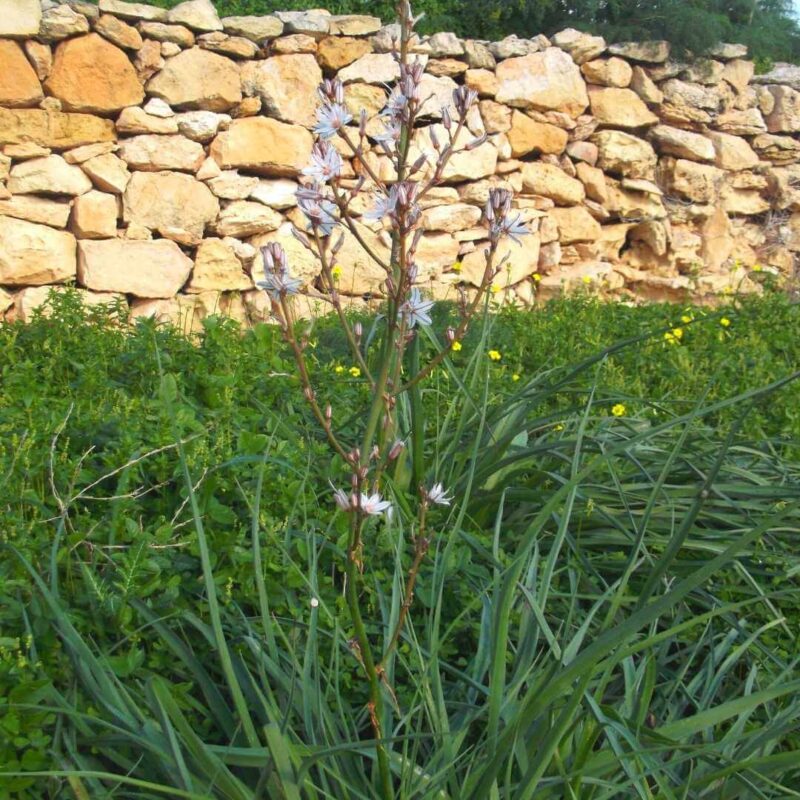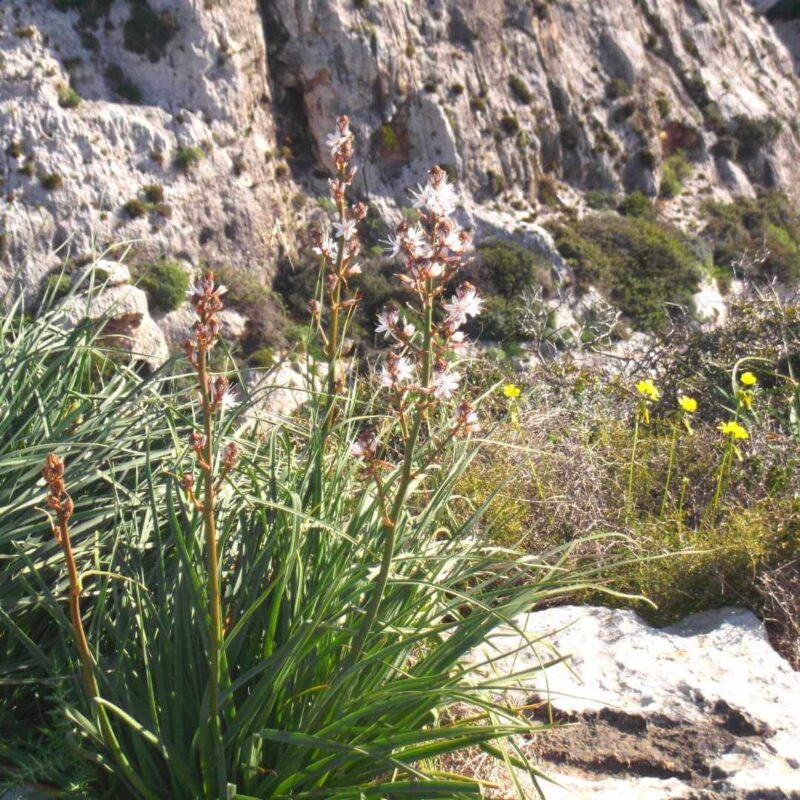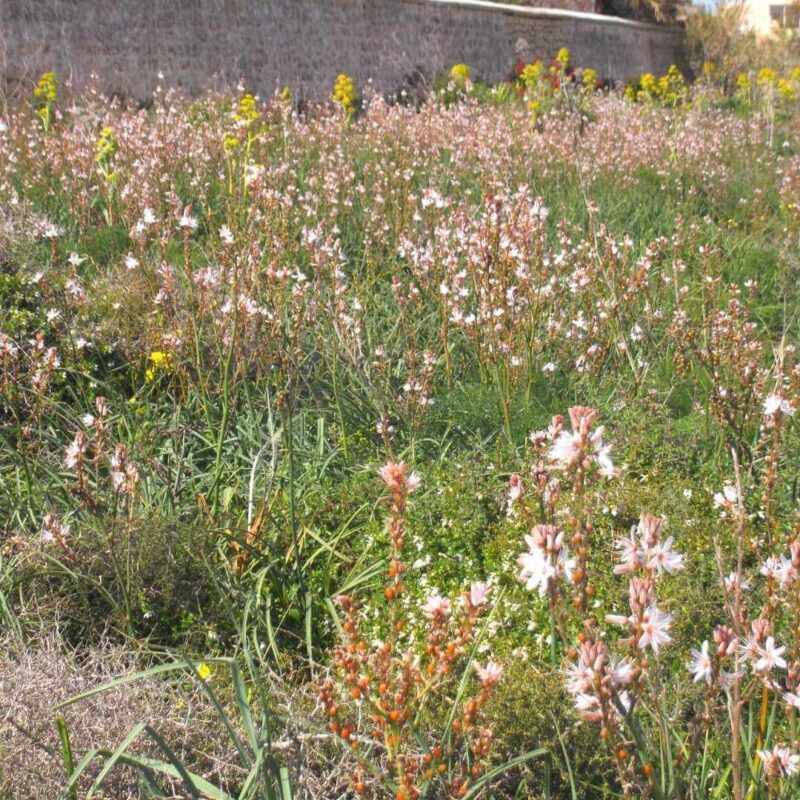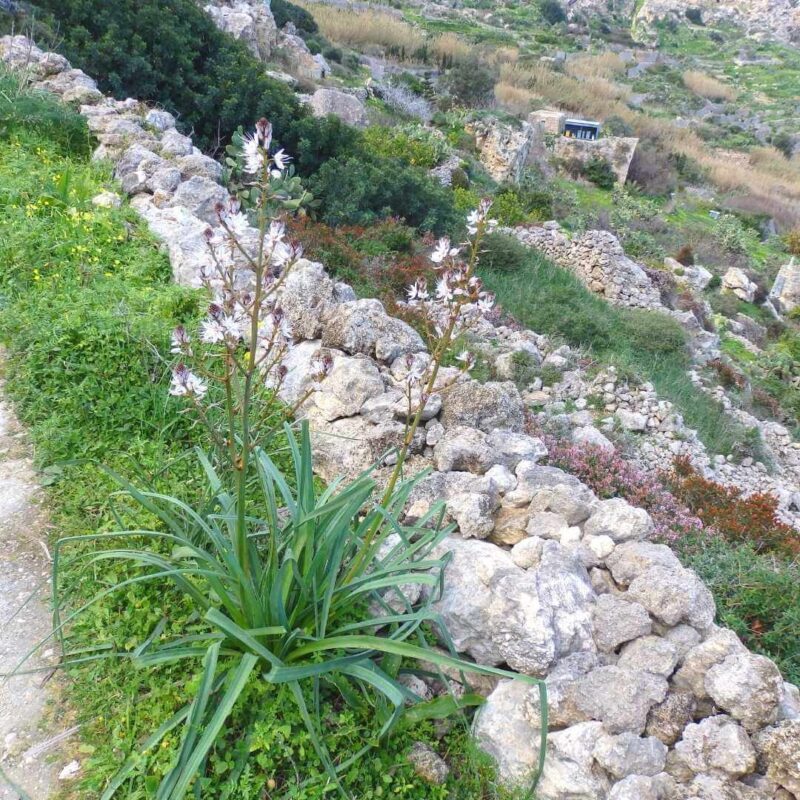Foraging Gozo. Sea Beet.
Sea Beet is found growing wild on Gozo and is a great alternative to chard.
Let’s learn about Ashphodel. Heléna has been intrigued by plants for as long as she can remember, so it’s no wonder she turned this passion into a deep and specialized knowledge by training in Herbal Medicine and Naturopathy. She has over 25 years of professional experience working in Slovenia, Serbia, Hungary, and luckily for us Gozo, where Heléna extensively researched Gozo’s common wild plants and captured all this gold in her book ‘Weeds For Health on Gozo‘.
Botanical name: Asphodelus aestvus-Brotero Family name: Liliaceae Maltese name: Berwieq Common names: Common Asphodel, Summer Asphodel Meaning of the Name: Asphodelus, from Greek ασφοδελοϛ, name for this plant. Asphodel means the unsurpassed, aestivus, from Latin: æstivus, of summer, as in summer, summer-like.

Asphodelus aestivus is an evergreen Perennial growing to 1 m (3ft 3in) by 0.3 m (1ft), with large, white terminal flowers, and radical long, numerous leaves. It is hardy to zone (UK) 8 and is not frost tender. On Gozo, it is in flower from January to April. The flowers are hermaphrodite (have both male and female organs) and are pollinated by insects.
“Fools, they do not know by how much the half is greater than the whole, nor what great advantage there is in mallow and asphodel.”
‘Works and Days’ ,Hesiod
Internal Uses: Asphodel was used in the treatment of several diseases by the Greeks and Romans, but is not employed in modern medicine. The root, gathered at the end of its first year, is acrid. The extract of the root is used as a laxative. Decoction of roots acts against ulcers. The seed is diuretic and contains oils rich in linoleic acid and are of value in preventing atherosclerosis. Said to be useful in menstrual obstructions and as antispasmodic.
External Uses: It is also applied externally to ulcers and inflamed parts of the body. The bruised root has been recommended for dissolving scrofulous swelling. The root warmed in olive oil is used as drops for earache. Ointment with powder of the root is used for vitiligo and any kind of white spots on the skin.
Edible Uses: Root – cooked. The root is fibrous according to one report whilst another says that the swollen root has radical root fibres. The plant is eaten as a vegetable. Tuber – cooked. Rich in starch. Dried and boiled in water it yields a mucilaginous matter which can be mixed with grain or potato to make a nutritious Asphodel bread. Boiling destroys the acrid principle in the tubers, rendering them quite pleasant to eat. Flowering stalk – cooked. Seed – roasted. The leaves are used to wrap burrata, an Italian cheese. The leaves and the cheese last about the same time, three or four days, and thus fresh leaves are a sign of fresh cheese, while dried out
Other Uses: The dried tuber is pulverized and mixed with cold water to make a strong glue that is used by bookmakers and shoemakers. A yellow dye is obtained from the tuber. An alcohol of excellent flavour has been obtained from plants growing abundantly in Algeria. In Spain and other countries, they are used as cattle fodder, especially for sheep. In Barbary, the wild boars eat them greedily.


The ancient planted the flowers near tombs, regarding them as the form of food preferred by the dead and many poems refer to this custom.
The asphodel, along with horta (wild edible greens such as the mallow and dandelion) helped the Greeks survive the harsh years of the Second World War, as their starchy roots saved many from dying of hunger.
Both Hippocrates and Dioscorides advocated that the asphodel roots should be roasted in the embers of a fire and then eaten mashed with figs and the shoot eaten fried; like a pakora.

Ingredients:
Method:
Keen to learn more? Click here to purchase the e-version of Weeds for Health on Gozo and here for more from this series.

Author and Images: Heléna Szöllősy.
Helena is an expert on the medicinal properties of plants having trained in Herbal Medicine and Naturopathy, specialising in Phytotherapy including Homeopathy, Aromatherapy, Apitherapy and Bach Flower Therapy.
'I came across Heléna Szöllősy's book 'Weeds For Health On Gozo' in the summer of 2020 and was instantly intrigued as I have always been convinced, (or told countless times by my lovely mum) that everything on the planet is here for good reason. Walking the dog every day across this beautiful island, I often wonder what is growing beneath my feet and what special qualities these wild and free beings could bestow on me (or in fact, my dog.) I was aimlessly Googling (usual) one morning and came across a site that listed Heléna's book. I felt a pang of excitement, jumped out of my seat and shouted to my husband 'Look someone has written a book about weeds on Gozo!' He was thankful I wouldn't ask him anymore. So I tracked this genius down and asked her if she would share her expertise with GITH. Lucky for us all, she gracefully accepted.' Andrea Britton
Sea Beet is found growing wild on Gozo and is a great alternative to chard.
Did you know Wild Asparagus Is really good for your skin? You can find it on Gozo all year round.
Wild Artichokes Are found growing wild on Gozo and super healthy for the liver.
Small White Clover, found growing wild on Gozo and known to be lucky makes a great pudding!